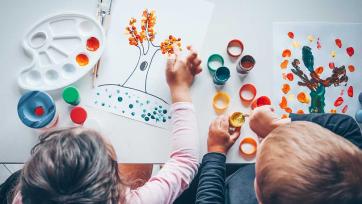Learning

The Most Fun and Easy Ideas for Coloring Activities for Preschoolers
Coloring sheets are a favorite activity here at Easy Peasy and Fun, and we have many of them to give to you. Come in, and don't forget to bring your crayons or coloring pencils! There are coloring sheets for infants, toddlers, kindergarteners, preteens, and teenagers that are easy to color, and there are also more complex designs that you will love coloring. Information about everything from domesticated animals to the alphabet may be found here. Even though all coloring pages are wonderful, children like some coloring pages more than others. You should print out the coloring pages that your children enjoy the most.
Unicorns
The unicorn is the only animal that can be seen in every hue. Coloring books are fun for both boys and girls since there are no restrictions on how they should be used. With this lovely set, you can go on an amazing coloring adventure.
Unicorns are often considered to be the most beautiful animals; we are certain that your children will enjoy coloring in these pictures of unicorns. Drawings that appeal to older children have more intricate elements but are still straightforward enough for toddlers and kindergarteners to enjoy. Therefore, grab your colored pencils, crayons, markers, or watercolors, and prepare for a relaxing coloring adventure with your children.
The fact that you may paint unicorns in whatever color is perhaps the finest part about these mythical creatures. If you want to build a white unicorn, you may use pastel colors, and if you want to make a unicorn that is midnight, you can use black and purple colors. Make the most awesome unicorn you can imagine by putting your creative skills to work.
Cars
These are for children who like playing with vehicles, particularly automobiles and trucks. It won't take long to locate one your children will like, regardless of whether they prefer ones that are cartoony or ones that appear genuine. This bundle comes in various designs, providing you with a wide range of options.
These exciting automobile coloring sheets are available for you and your children to color. The vehicles vary from cartoonish to realistic in both speed and appearance. There are many coloring sheets on this website that your children will enjoy using. Therefore, I would ask that you switch on your computer, print them off, and then begin coloring!
Realistic photos
There is something for everyone in this collection of coloring sheets revolving around automobiles. You can print either simplistic and entertaining images for smaller children or more realistic and entertaining for older children. After coloring their preferred designs, they may utilize our detailed tutorial to help them create and construct their vehicle.
Dinosaur
Coloring papers of dinosaurs should be kept on hand at all times since most children like learning about and coloring pictures of prehistoric animals. Dinosaurs capture the imagination of people of all ages, which is not surprising given the captivating nature of these extinct animals.
They will surely enjoy coloring in these fantastic dinosaur coloring sheets, which come in a collection of 30 and include a variety of dinosaurs and patterns. The ones that are straightforward and have a lot of blank areas for coloring will appeal to younger children, while those with more details will appeal to older children.
Are you ready to see how these incredible ancient creatures continue to thrive? You are welcome to see all 30 dinosaur coloring sheets available to our members. After they have finished coloring, you may provide them with a sketching task. In this detailed, step-by-step instruction, you will learn how to draw a dinosaur.
Flowers
There are flower baskets that are blossoming as well as solitary blossoms that are smiling. You may paint them whenever you like, but spring is the most enjoyable time. Be sure you have enough pastel hues since they are the ones that bring out the finest in these designs. Although springtime is when flowers look most stunning, you may enjoy coloring flower printables at any time of year. When you color them, you don't have to limit yourself to just one hue, which is one of the activities' many advantages.
Because they are popular with children of varying ages, we made sure there were various designs. Some are straightforward, with large areas that are simple to color in, and others are more challenging yet appealing to older children. Because not everyone has the same taste in flowers, we made sure to include a variety of them. Flowers such as tulips, roses, sunflowers, daisies, and many more may be found here. Everyone is welcome to take as many flowers as they want.
Mermaids
The mermaid is another stunning creature that many people like drawing and coloring. When it comes to talking about creatures with magically colored fur, any hue will do. There is nothing except space above us. Because there are so many distinct pictures, it will take your children a long time to color them.
Princess
Additionally, the concept of a princess is quite appealing to many people. It's amusing to think about what it would be like to live like a princess if you were one. At least in fairy tales, princesses are often rather awesome. You will have a wide selection of designs to pick from, all of which have been thoughtfully made, and we hope your kid will appreciate them as much as we do.
Fairies
The children and we can't get enough stories about fantastic beasts. Another sort of well-known figure is the fairy. Fairies are everywhere. They would be even more stunning if their wings were a kaleidoscope of hues in every hue of the spectrum. You and your children (as well as yourself) will benefit from selecting a pattern appropriate for their level of sophistication.